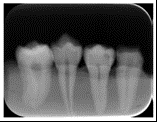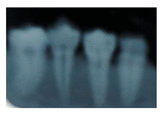Diagnostic accuracy of Cone Beam Computed Tomography, conventional and digital radiographs in detecting interproximal caries
- PMID: 28316670
- PMCID: PMC5348938
Diagnostic accuracy of Cone Beam Computed Tomography, conventional and digital radiographs in detecting interproximal caries
Abstract
Presently, various imaging methods are available for the disclosure of proximal caries. Some recent studies have attempted to determine the diagnostic accuracy of available modalities, but they have shown variable results. Aim: This study was carried out to recognize and examine the correctness of cone-beam computed tomography (CBCT), regular radiographs and the nondirect digital system in the disclosure of interproximal caries. Materials and Method: In this observational tryout study, forty-two extracted non-cavitated, unrestored person molar and premolar teeth were placed in the blocks with proximal surfaces in touch. Then they were appraised by CBCT, formal radiographs and the nondirect digital system for the disclosure of interproximal caries. Four oral and maxillofacial radiologists used a 4-point scale to assess the pictures for the existence or absence of proximal caries. Caries depth was specified by histological examination. The gathered data were assessed by SPSS software using Weighted Kappa and Friedman test. Results: Statistics demonstrated that the accuracy of the indirect digital system was somewhat better than conventional systems. The accuracy of the indirect digital system was better than cone beam system, and this difference was statistically significant. Conclusion: The digital system was better than CBCT in the disclosure of proximal caries. The formal radiography fell in between the two other systems without a statistically significant deviation in detecting caries. Thus, CBCT is not advised to detect proximal caries because of the higher radiation dose.
Keywords: Cone Beam CT; dental caries; diagnosis; digital; radiography.
Figures
Similar articles
-
Accuracy of Cone-beam Computed Tomography and Extraoral Bitewings Compared to Intraoral Bitewings in Detection of Interproximal Caries.J Contemp Dent Pract. 2020 Dec 1;21(12):1361-1367. J Contemp Dent Pract. 2020. PMID: 33893259
-
[Accuracy of computer aided measurement for detecting dental proximal caries lesions in images of cone-beam computed tomography].Zhonghua Kou Qiang Yi Xue Za Zhi. 2017 Feb 9;52(2):103-108. doi: 10.3760/cma.j.issn.1002-0098.2017.02.010. Zhonghua Kou Qiang Yi Xue Za Zhi. 2017. PMID: 28253585 Chinese.
-
Diagnostic accuracy of cone beam computed tomography scans compared with intraoral image modalities for detection of caries lesions.Dentomaxillofac Radiol. 2008 Jan;37(1):18-22. doi: 10.1259/dmfr/87103878. Dentomaxillofac Radiol. 2008. PMID: 18195250
-
New evolution of cone-beam computed tomography in dentistry: Combining digital technologies.Imaging Sci Dent. 2019 Sep;49(3):179-190. doi: 10.5624/isd.2019.49.3.179. Epub 2019 Sep 24. Imaging Sci Dent. 2019. PMID: 31583200 Free PMC article. Review.
-
Use of Digital Diagnostic Aids for Initial Caries Detection: A Review.Dent J (Basel). 2023 Sep 28;11(10):232. doi: 10.3390/dj11100232. Dent J (Basel). 2023. PMID: 37886917 Free PMC article. Review.
Cited by
-
The impact of different dental restorations on detection of proximal caries by cone beam computed tomography.Clin Oral Investig. 2022 Mar;26(3):2413-2420. doi: 10.1007/s00784-021-04207-w. Epub 2021 Oct 3. Clin Oral Investig. 2022. PMID: 34601634
-
Application of Mask R-CNN for automatic recognition of teeth and caries in cone-beam computerized tomography.BMC Oral Health. 2025 Jun 6;25(1):927. doi: 10.1186/s12903-025-06293-8. BMC Oral Health. 2025. PMID: 40481434 Free PMC article.
-
Do fully erupted third molars affect the dental and periodontal health of adjacent second molars? A CBCT-based retrospective study in the Yemeni population.BMC Oral Health. 2025 Aug 11;25(1):1312. doi: 10.1186/s12903-025-06667-y. BMC Oral Health. 2025. PMID: 40790205 Free PMC article.
-
Radiographic modalities for diagnosis of caries in a historical perspective: from film to machine-intelligence supported systems.Dentomaxillofac Radiol. 2021 Jul 1;50(5):20210010. doi: 10.1259/dmfr.20210010. Epub 2021 Mar 4. Dentomaxillofac Radiol. 2021. PMID: 33661697 Free PMC article. Review.
-
Evaluation of diagnostic accuracy of CBCT and intraoral radiography for proximal caries detection in the presence of different dental restoration materials.BMC Oral Health. 2023 Jun 23;23(1):419. doi: 10.1186/s12903-023-02954-8. BMC Oral Health. 2023. PMID: 37353807 Free PMC article.
References
-
- Kalathingal SM, Mol A, Tyndall DA, Caplan DJ. In vitro assessment of cone beam local computed tomography for proximal caries detection. Oral Surgery, Oral Medicine, Oral Pathology, Oral Radiology, and Endodontology. 2007;104:699–704. - PubMed
-
- Schneiderman A, Elbaum M, Shultz T, Keem S, Greenebaum M, Driller J. Assessment of dental caries with digital imaging fiber-optic translllumination (DIFOTITM): in vitro Study. Caries Research. 1997;31:103–110. - PubMed
-
- Zhang Zl, Qu XM, Li G, Zhang ZY, Ma XC. The detection accuracies for proximal caries by cone-beam computerized tomography, film, and phosphor plates. Oral Surgery, Oral Medicine, Oral Pathology, Oral Radiology, and Endodontology. 2011;111:103–108. - PubMed
-
- Cheng JG, Zhang ZL, Wang XY, Zhang ZY, Ma XC, Li G. Detection accuracy of proximal caries by phosphor plate and cone-beam computerized tomography images scanned with different resolutions. Clinical oral investigations. 2012;16:1015–1021. - PubMed
-
- Wenzel A. Digital radiography and caries diagnosis. Dentomaxillofacial Radiology. 1998;27:3–11. - PubMed
LinkOut - more resources
Full Text Sources





